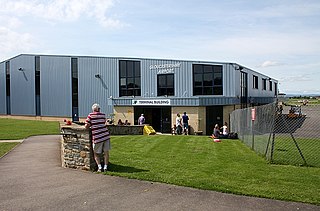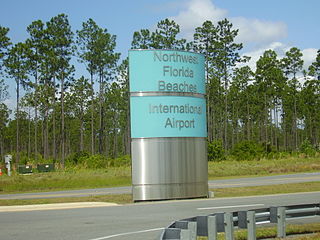
Merrill C. Meigs Field Airport was a single-runway airport in Chicago that was in operation from 1948 to 2003, when it was bulldozed overnight by then-mayor Richard M. Daley. The airport was located on Northerly Island, an artificial peninsula on Lake Michigan adjacent to downtown Chicago, the second-largest business district in North America. By 1955, Meigs Field had become the busiest single-strip airport in the United States. The airport was a familiar sight on the downtown lakefront. The latest air traffic tower was built in 1952, and the terminal was dedicated in 1961. The airfield was named for Merrill C. Meigs.

Long Beach Airport is a public airport three miles northeast of downtown Long Beach, in Los Angeles County, California, United States. It is also called Daugherty Field, named after local aviator Earl Daugherty. The airport was an operating base for JetBlue, but this ended on October 6, 2020, as the carrier moved its operating base to Los Angeles International Airport, amidst the then-ongoing COVID-19 pandemic. Consequently, Southwest Airlines became the airport's largest airline.
Panama City–Bay County International Airport(IATA: PFN, ICAO: KPFN, FAA LID: PFN) was a public airport 3 miles (4.8 km) northwest of Panama City, in Bay County, Florida. It was owned and operated by the Panama City–Bay County Airport and Industrial District. All airline services moved to the Northwest Florida Beaches International Airport on May 22, 2010, but the airfield was open to general aviation aircraft until October 1, 2010. The grounds will eventually be turned over to LUK-MB1 LLC, which plans to remove the runways and build homes, shops, walking trails and a marina.

Palm Beach International Airport is a public airport in Palm Beach County, Florida, located just west of the city of West Palm Beach, Florida, United States, for which it serves as the primary airport. It is also the primary airport for most of Palm Beach County, serving the suburbs and cities of Wellington, Boynton Beach, Jupiter, and Palm Beach Gardens. It is the third busiest airport in the Miami metropolitan area after Miami International Airport and Fort Lauderdale–Hollywood International Airport. The airport is operated by Palm Beach County's Department of Airports. Road access to the airport is direct from I-95, Southern Boulevard, and Congress Avenue. The airport is bordered on the west by Military Trail.

Kalamazoo/Battle Creek International Airport is a county-owned public airport in Kalamazoo, Kalamazoo County, Michigan, US, 3 miles (4.8 km) southeast of Downtown Kalamazoo. The airport is located approximately 20 miles (32 km) west of the city of Battle Creek. It is included in the Federal Aviation Administration (FAA) National Plan of Integrated Airport Systems for 2023-27, in which it is categorized as a non-hub primary commercial service facility.

Roosevelt Field is a former airport, located in Westbury, Long Island, New York. Originally called the Hempstead Plains Aerodrome, or sometimes Hempstead Plains field or the Garden City Aerodrome, it was a training field for the Air Service, United States Army during World War I.

Essendon Fields Airport, colloquially known by its former name Essendon Airport, is a 305 ha public airport serving scheduled commercial, corporate-jet, charter and general aviation flights. It is located next to the intersection of the Tullamarine and Calder Freeways, in the north western suburb of Essendon Fields of Melbourne, Victoria, Australia. The airport is the closest to Melbourne's City Centre, approximately an 11 km (6.8 mi) drive north-west from it and 8 km (5.0 mi) south-east from Melbourne–Tullamarine Airport. In 1970, Tullamarine Airport replaced Essendon as Melbourne's main airport.

Fort Worth Meacham International Airport is a general aviation airport located near the intersection of Interstate 820 and Business U.S. Highway 287 in Fort Worth, Texas, United States. It is named after former Fort Worth Mayor Henry C. Meacham. The airport covers 745 acres.

Gloucestershire Airport, formerly Staverton Airport, is a small airport at Churchdown, England. It lies 3.5 nautical miles west of Cheltenham, near the city of Gloucester and close to the M5 motorway. Its operator claims it to be Gloucestershire's largest general aviation airfield, and it is regularly used for private charter flights to destinations such as Jersey and Guernsey.

Lincoln Airport is a public/military airport five miles (8.0 km) northwest of downtown Lincoln, the state capital, in Lancaster County, Nebraska, United States. It is owned by the Lincoln Airport Authority and is the second-largest airport in Nebraska. It is included in the Federal Aviation Administration (FAA) National Plan of Integrated Airport Systems for 2023–2027 in which it is categorized as a non-hub primary commercial service facility. It has four gates with jetways, to be, as of February 2022, expanded to six.

Daytona Beach International Airport is a county-owned airport located three miles (5 km) southwest of Daytona Beach, next to Daytona International Speedway, in Volusia County, Florida, United States. The airport has 3 runways, a six-gate domestic terminal, and an international terminal. Daytona Beach is the headquarters of Embry-Riddle Aeronautical University.

Westfield-Barnes Regional Airport is a joint civil-military airport in Hampden County, Massachusetts, three miles (6 km) north of Westfield and northwest of Springfield. It was formerly Barnes Municipal Airport; the National Plan of Integrated Airport Systems for 2011–2015 categorized it as a general aviation facility. Westfield-Barnes is one of Massachusetts' largest airports with a strong flight training, general aviation, and military presence. It is also known as Barnes Air National Guard Base.

Wilmington Airport is an airport located in unincorporated New Castle County, Delaware, near Wilmington, Delaware. Owned by New Castle County and operated under a lease agreement with the Delaware River and Bay Authority, it is five miles (8 km) south of Wilmington and about 30 miles (50 km) from Philadelphia. It is included in the Federal Aviation Administration (FAA) National Plan of Integrated Airport Systems for 2017–2021, in which it is categorized as a non-hub primary commercial service facility.

Igor I. Sikorsky Memorial Airport is a public airport in Fairfield County, Connecticut, United States, owned by the city of Bridgeport. It is three miles (6 km) southeast of downtown, in the town of Stratford. It was formerly Bridgeport Municipal Airport.

Lakeland Linder International Airport is a public airport five miles southwest of Lakeland, in Polk County, Florida. The Federal Aviation Administration (FAA) National Plan of Integrated Airport Systems for 2017–2021 categorized it as a national reliever facility for Tampa International Airport. The airport has a Class 1 Federal Aviation Regulation (FAR) Part 139 operating certificate allowing passenger airline flights.

New Smyrna Beach Municipal Airport, also known as Jack Bolt Field, is a public airport located three miles (5 km) northwest of the central business district of New Smyrna Beach, a city in Volusia County, Florida, United States. It is owned by the City of New Smyrna Beach.

Imeson Field, also known as Jacksonville Imeson Airport, was the airport serving Jacksonville, Florida, from 1927 until its closing in 1968. It was known as Jacksonville Municipal Airport prior to World War II, Jacksonville Army Airfield when the United States Army Air Forces controlled the facility during World War II, and at its closing the airport was Jacksonville – Thomas Cole Imeson Municipal Airport.

Northwest Florida Beaches International Airport is a public airport 18 miles (29 km) northwest of Panama City, Florida, United States, in Bay County. The airport is owned by the Panama City-Bay County Airport & Industrial District, and is north of Panama City Beach, near West Bay. It replaced Panama City–Bay County International Airport, which was located in Panama City.
Maitland Airport, also known as Russell Field is a general aviation airport located in the suburb of Rutherford, approximately 5 km (3.1 mi) from Maitland in the Australian state of New South Wales. There are currently no airline services, with the airfield catering mostly to general aviation and recreational category aircraft. The airport has been owned and operated by the Royal Newcastle Aero Club since 1963 and shares a large training area with the nearby Cessnock Airport. Throughout its history, the airport has played host to many airshows, races and flying competitions. The field is named for the fifth President of the Royal Newcastle Aero Club, Robert Russell, who suffered a fatal heart attack while on the premises in 1966.

Dallas Love Field is a city-owned public airport 6 miles northwest of downtown Dallas, Texas. It was Dallas' main airport until 1974 when Dallas/Fort Worth International Airport (DFW) opened. Love Field covers an area of 1,300 acres (530 ha) at an elevation of 487 feet (148 m) above mean sea level and has two runways.





















